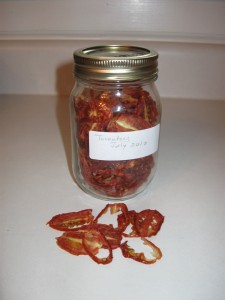Simply slicing them about 1/4″ thick and arranging them on the dehydrator trays, then letting them dry overnight produced wonderful, bright-red, delicious slices of summer. When you eat a dried tomato, you’ll be surprised at the very distinct flavor. Since tomatoes are used in so many things we make in the kitchen, including chili, many soups, italian foods, etc., dried tomatoes offer lots of possibilities as a dried food. Many people take the dried tomato slices and grind them into tomato powder. The powder can then be used to reconstitute for use as a sauce or paste. The powder also takes less space for storage.
I also tried making the tomatoes into a puree and then drying them like a fruit roll-up. This worked well, but I found it was more difficult to get them really dry, so they had a shorter shelf life. It did work nicely when I wanted to make chili and wanted to get the tomato sauce flavor. I just dropped in a tomato rollup and added a bit more liquid to the recipe.
If you, as I did, have an abundance of the cherry tomatoes that you want to dry, simply slice them in half or thirds and place skin-side down on the trays and dry as you would regular-sized tomato slices. You can even use them for your own sun-dried tomatoes by covering the dried tomatoes with olive oil and storing in the refrigerator until use.
After drying tomatoes to a very dry degree, as recommended when long-term storage is the plan, I store some in mason jars and some in mylar bags. For those stored in mylar, I also include oxygen absorbers before sealing the bags to help them to store longer. I have sometimes used oxygen absorbers in the mason jar storage, but not always. I do, however use a vacuum sealer to pull as much air out of the jars as possible before storing in my cupboard. This method has worked very well for me. After nearly three years of storage in mason jars, the tomatoes I’m still enjoying in my cooking from my first summer garden’s bumper crop still look bright red and beautiful and have a wonderful flavor.
I realize that canned tomatoes and tomato sauce are generally pretty inexpensive in the grocery stores, so many people would, perhaps, wonder if it is really worth the trouble to store them from your garden… I would say it is very satisfying to eat food you grew yourself, knowing that no pesticides were used and remembering the pleasure from picking them from your own vines. I don’t really think you can put a price on that.
As I have mentioned before, I love my Excalibur (9-tray) dehydrator, but I also use my Foodsaver vacuum sealer constantly. The Foodsaver has a very convenient hose attachment that allows you to seal standard and wide-mouth mason jars to increase storage life. I made a YouTube video demonstration of this some time ago (please realize that my oldest boy did the camera work and there was a bit of extra camera movement that some have not appreciated!).
Plan ahead this winter as you pore over seed catalogs, planning for your summer garden. Leave plenty of room for tomatoes!
You might be interested in this earlier post about dehydration: Dehydrating From Your Garden
